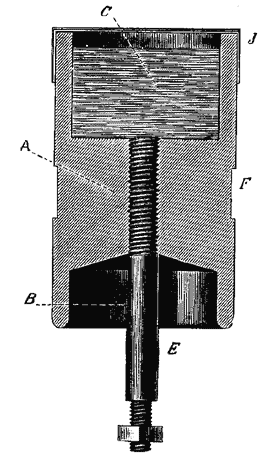[Trade Journal]
Publication: The Electrical Engineer
New York, NY, United States
vol. 13, no. 204, p. 341, col. 1-2
THE HEWETT POROUS OIL INSULATOR
By R. J. Hewett
Believing that the problem of a successful open conduit trolley system for street car propulsion depends in a measure upon efficient insulation of the naked conductor, the writer has worked out this invention with a view of filling such requirements. In looking at the conditions which exist in an open conduit, we see that the humidity of the atmosphere will always be greater than in the open air above ground. Aside from this, in dry weather a certain quantity of dust will find its way into the conduit and adhere to the insulators. From this the writer was led to the conclusion that an insulator to be used under such adverse conditions should be designed so as to obviate these difficulties as much as possible.
In an article on oil insulators for high tension currents, by F. L. Pope, which appeared in The Electrical Engineer of October 25, 1892, there was given a brief description of an oil insulator invented and patented by the writer. The process of development has produced forms of insulators much superior to the original ones, among them being the improved form shown in section in the accompanying engraving.
 |
| The Hewett Porous Oil Insulator. |
The body of the insulator A is composed of wood, and has the usual bell shape at the bottom. The upper part of the insulator is formed into a cup C, which is filled with insulating oil, which saturates the entire porous body of the insulator and passes out in the bell B, the crown of which is beveled, as shown. The beveled shape of the crown causes the oil to run outward to the rim, down which it flows in a thin film to the edge, where it drips off. The bell of the insulator is thus supplied with a constantly renewed surface of oil, which carries away any particles of dirt that may lodge upon it, and thus prevents the formation of a continuous film of moisture even in the most humid condition of the atmosphere. A cap J covering the oil cup can be removed when necessary to refill the cup with oil. A groove F is provided for receiving a clasp, by means of which the insulator is attached to the conduit or manhole. To the end of the shank E is attached the wireholder.
Experimental work has shown that wood is more suitable than porous earthenware. Aside from being cheaper and less liable to breakage, it is more suitable on account of its peculiar porous structure, it being quite porous in the direction of its fibrous structure, but only slightly porous in a transverse direction. This peculiar porous property of wood causes the oil to pass out of the body of the insulator more freely at the place where it is most needed, that is, in the bell.
Woods of a rather close grain, such as wild cherry and soft maple, are most suitable. The wood is split and cut into billets of suitable size, and treated by a special process which drives out all moisture, resin and other volatile matter, and thoroughly shrinks it so that no further shrinkage can take place. After this the billets are turned down to the proper shape and the shank put in place. This special treatment obviously improves the insulating qualities of the insulator.
The insulator is applicable to other cases of a similar nature, such as tunnels and mines worked by electric mining locomotives and other cases where naked wires are to be insulated under adverse conditions of atmospheric humidity.
